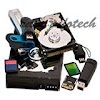pic
This article teaches about the Top 7 most common SSD problems and solutions. You’ll also find great tips on what to do before and after installing your new SSD!
What is SSD and How its Work:
Solid State Drives (SSDs) are fast and reliable storage devices that use a different type of memory than traditional hard drives. SSDs don’t have spinning disks like hard drives so they can access data much faster. Solid State Drives (SSDs) are quickly becoming the storage choice of many computer users. Their fast speed, lack of moving parts, and low power consumption have made SSDs popular for laptops, desktops, and gaming systems.
However, like any new technology, there can be some issues with SSDs that users may not be aware of. This blog article will discuss some of the most common SSD problems and solutions.
Top 7 Most Common SSD Problems and Solutions
There are several things to keep in mind regarding SSDs, particularly if you’re unfamiliar with the technology. Here are some of the top 7 most common SSD problems and solutions-
pic
- Poor Performance- This may be due to a corrupted file system, incompatibility with your operating system, or insufficient storage space on the SSD. You may need to reformat your SSD or install a new operating system to improve performance.
- Failed Drives- If you notice a decrease in drive activity or an increase in errors, your SSD may be failing. In most cases, you can repair this by replacing the drive unit. However, if the drive is too damaged or defective to be salvaged, it will need to be replaced.
- Frozen Zones- When data is written to an SSD, it’s written in small pieces called blocks. If too many small blocks are on the disk at once (due to low capacity or fragmentation), the disk can freeze and fail. To prevent this problem, periodically defragment your SSD using a third-party utility.
Read Also: How Much Does A Laptop Hinge Repair or Replacement Cost?
- Lost Data Due to power outages or virus attacks-An unprotected SSD will not be able to protect itself against such attacks; it will seek out the most secure location for its data (normally your system’s RAM) and then preserve that instead. This can result in lost data, especially if you don’t have an off-site backup.
- Failed system board or other Hardware- If you’re having trouble recovering from a power outage or virus attack, but the SSD is still working, there may be a problem with your motherboard and storage controller. If this happens while there’s no power at all, the drive is obviously toasted, but perhaps your BIOS has been corrupted and can’t recover properly.
- Water damage/flood- Layers of microscopic silicon oxide circuits manufacture SSDs. Eventually, there will be a tear or crack in the circuit. This can happen even without any external damage, and it’s especially common with flash-based drives because they are typically environmentally sealed.
- Physical Damage- If a hard drive has been dropped or physically hurt in some way, it will be extremely difficult to recover data from it. The same is true of a flash drive, which has problems. The capacity of a flash drive is so small that it’s particularly vulnerable to physical damage, which can deteriorate the chips and render the drive unusable.








0 Comments